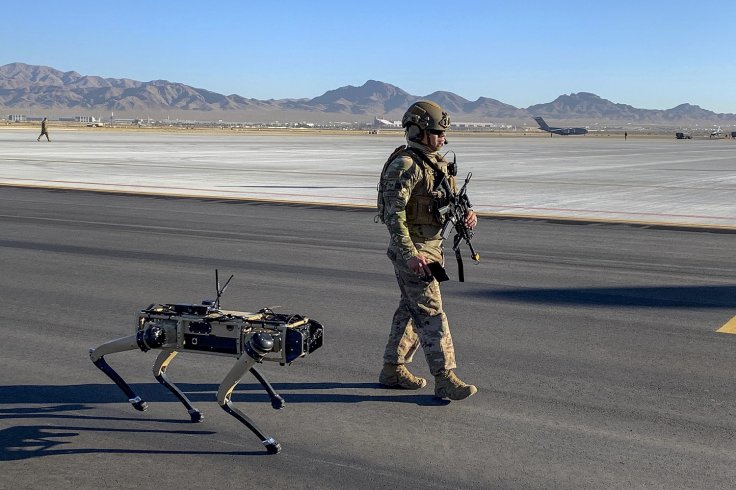With technological advancements, countries are leaning more towards machines to win battles so that fewer human lives are lost. One big development is in the field of advanced robotics. Couple that with artificial intelligence and no human can match its power. The U.S. Air Force (USAF) recently conducted large-scale tests of such machines.
The USAF through the tests were demonstrating how the new Advanced Battle Management System (ABMS) would play out in a real-life scenario. The system has been developed to collect, process and share data within the U.S. defense forces and the allies. Earlier this year, ABMS had also gone through a live-fire drill with satellite communication, partly provided by SpaceX.
The ABMS drill was one of the largest in the U.S. has ever conducted. It involved 65 government teams from all the defense departments including the Coast Guard besides 35 military divisions. In addition to that, 70 industry partners were also involved. The demonstration was conducted in four domestic test facilities and 30 other locations.

However, the recent drills are just a signal of how modern-day military may look like. With the 5G networks and artificial intelligence, machines would be marching into wars with a minimal human intervention. Let's see how technological advancements are shaping the future defense system.
Advanced Communication
The fifth-generation mobile network or 5G has been a boon for defense applications. Its high-speed wireless bandwidth helps defense forces establish a better communication system that can be used for advanced weapons systems and inter-department communication. The U.S. Department of Defense holds a large portion of the millimeter-wave spectrum that 5G technology uses.
During the recent mock drills, USAF put 5G to test. Using the streamlined sensors, it conducted mock drills to detect and shoot down Russian missiles. It was successful as the high bandwidth allowed almost instantaneous cloud computing for better situational awareness. A large part of the $3.3 billion for ABMS will go to such advanced networks and over the next five years, the existing facilities will be modernized.

Artificial Intelligence
With advanced communications, another pivotal area defense is leaning towards is integrating artificial intelligence (AI) to conduct missions. There are multiple applications of AI. From threat analysis and surveillance to cyber warfare and automated weapons systems, AI is seen as the jack of all trades. Currently, the U.S., Russia and China have some degree of automation using AI.
The latest USAF drills also included AI. When the mock Russian missiles were shot down, an AI system analyzed the target. Dubbed as LAWS (Lethal Automated Weapon System), it is a special class of modern-day military might that uses sensors and algorithms to independently destroy a target without manual human intervention.
However, a fully-automated weapon system is still not a part of the U.S. military. But China has already started selling its fully-automated drones that are capable of striking target without human intervention that has forced the U.S. to step up its game.

Advanced Robotics
Within the fully-autonomous system, robotics plays a big part. There were multiple attempts during the Cold War to have machines do the army's jobs but most of them weren't successful due to limitations of technology. But today, it is not only possible with technological advancement but it is in use to some degree already. The U.S. military uses a variety of unmanned guard vehicles (UGVs) that are deployed in a hazardous situation where human intervention might not be possible. With AI integration, such UGVs can work independently in guarding and carrying out missions — such as reconnaissance, patrolling and even shooting down targets — with minimal human intervention.
USAF's drills too had the presence of robots. It used quadrupedal "robot dogs" to defend the perimeter at the Nellis Air Force Base, The Drive reported. Similar to the robot dogs developed by Boston Dynamics that surfaced in Singapore during the Coronavirus pandemic lockdown to patrol parks, army robots are more advanced. Developed by Ghost Robotics, the model, known as Vision 60, was designed to carry out remote inspection, mapping, distributed communication and ISR (Intelligence, Surveillance and Reconnaissance) missions.
Previously, drills with such robot dogs were conducted but the tests were unsuccessful due to lack of bandwidth. But now that 5G has been implemented, the Quadrupedal Unmanned Ground Vehicle (Q-UGVs) can communicate more efficiently to provide persistent security.

"Our defenders employed robot dogs. These robot dogs are a new technology that we're testing as part of the exercise. The dogs give us visuals of the area, all while keeping our defenders closer to the aircraft," said Master Sgt. Lee Boston, CR team chief for the drill.
However, there are other applications of robotics in the military. Countries around the world have also tried developing an exoskeleton that would give them an advantage in the battlefield to not only carry heavyweight but also protect them from heavy firing. Russia's Uran-6 mine clearance robot and the operator also use an exoskeleton, known as Ratnik, which is a combat suit. The U.S. Army too has trialed an exoskeleton that would provide strength, endurance and protect soldiers.









